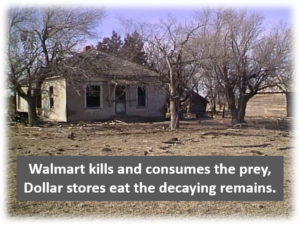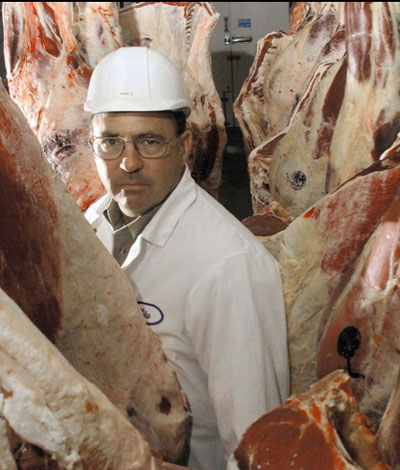Mr. Chairman, members of the Ag Committee, thank you for the opportunity to speak to you today. I have been involved in the cattle feeding business for twenty-five years. I have become increasingly concerned about the high levels of corporate concentration and the many related problems resulting to agricultural producers, rural communities and consumers. I represent the Cattlemen’s Legal Fund, a group of cattle producers who have filed a lawsuit against IBP for what we believe are anti-competitive practices. Your bills LB832, 833, 834 and 835 addressing anti-competitive practices by the packers, complete price reporting and meat labeling for the State of Nebraska give us hope and encouragement. We stand in full support.
“It has been brought to such a high degree of concentration that it is dominated by few men. The big packers, so called, stand between hundreds of thousands of producers on one hand and millions of consumers on the other. They have their fingers on the pulse of both the producing and consuming markets and are in such a position of strategic advantage they have unrestrained power to manipulate both markets to their own advantage and to the disadvantage of over 99 percent of the people of the country. Such power is too great, Mr. President, to repose in the hands of any men.”
These words were spoken on the floor of the U.S. Senate by Wyoming Senator John B. Kendrick in 1921. The Packers and Stockyards Act was legislated to prevent a packer monopoly from occurring again.
Five packers controlled less than 50% of the market in 1921. Today four firms control 87% of beef packing. I believe one packer, IBP leads the way in setting the price and the other packers follow. At the same time as four firm packer concentration has increased from 36% twenty years ago to today’s current high levels, consumers have continued to pay increasingly higher prices while producers have continued to receive less of the consumers’ meat dollar. Today the cattle producer has lost approximately 20% of the consumer dollar or about $300 per head. This has occurred at the same time the cattle producer has done more to produce a better product and the packer and retailer have done less.
Anti-competitive practices, evidenced by what IBP termed the “Death March”, have eliminated competitors as well as producers. Independent packers have been regulated and predatory priced out of business. We are now left with a packing monopoly that is stealing from both producers and consumers as well as threatening not only our food supply but a safe food supply. The laws are currently in place to prevent this tragedy;
however the Secretary of Agriculture, Dan Glickman lacks the political will to enforce the Packers and Stockyards Act of 1921.
The P&S Act basically says that if what a packer is doing has the effect of reducing competition, they must stop. The Secretary has the power to impose injunctive relief, yet he does nothing.
It has been proven that IBP uses captive supplies, those inventories of cattle available to IBP outside of the competitive market, to lower prices paid to producers. Recently IBP’s highly secretive captive supply arrangements have provided them with captive supplies as high as 122%. The cash market determines the value of these captive cattle. What is the cash market if the price leader IBP, doesn’t need any cattle?
The big packers do business with each other. Corporate Roundup – “In a move that made cattle feeders livid and has drawn attention from government regulators, ConAgra sold cattle to IBP for slaughter in late January. ConAgra (and IBP) pushed cattle prices down with the deal, and left cattle feeders wondering if a competitive market — or laws against market manipulation — were still in force.”
USDA market reporters confirmed ConAgra sold 7250 head of cattle to IBP, breaking the cash market approximately $60 per head from cattle feeder asking prices. In today’s market a sale of this volume causes the entire industry to flush their inventories of cattle at the going low price. Feeders have only minutes to decide on the take it or leave it offers by the big packers.
A past ConAgra executive recently informed cattle producers and feeders that ConAgra consistently used their own cattle inventories, although not market ready, to stay out of the cash market.
I commend the State of Nebraska for taking the important and necessary steps to protect your producers and save your rural communities. Our federal government has proven that left up to them we will be left without a competitive independent agriculture.
Many packer promoted studies show there is no problem with captive supplies. Any feedlot manager with a Monday morning showlist knows this is untrue.
Economists Russell Parker and John Connor in their study, “Monopoly Effects on Producers and Consumers,” related the following:
“In about 1950, economists and econometricians started doing statistical studies relating the level of concentration to the level of profits. Some of the studies related concentration to the level of prices, and others to price-cost margins computed by the Bureau of the Census. All of these variables roughly measure the same thing: the costs of high concentration. Nearly all of the studies showed a positive relationship: as concentration increases, profits, consumer prices, and price-cost margins increased.
“The studies were also interested in looking for critical levels of concentration. If they could be identified they would be very useful to public policy considerations. Is there some range of concentration where industries are workably competitive? Is there a concentration value below which antitrust authorities and other public policy organizations shouldn’t be concerned? Beyond this critical point does concentration rapidly become a problem?
“Models which were specified to determine if there was a critical level have shown that up to about the 40-percent level of four-firm concentration, there is no evidence that concentration is related to the levels of prices, profits or price-cost margins. In other words, industries with that level of concentration or lower are effectively competitive.
“Starting at about the 40-percent level of concentration, prices and profits start increasing and go up rapidly to about the 60-percent level of concentration where they level off. There is no significant further increase in prices or profits beyond about the 60-percent level of four-firm concentration. The conclusion is (pointing at the figure) that the effect of monopoly starts appearing when concentration goes above 40 percent and by the time concentration reaches 60 percent an industry is quite monopolistic.”
This information backs up my contention that the market is simply an illusion. The market is totally disconnected from supply and demand and is simply what the packer wants it to be.
I believe price is maintained at the level at which the producer can be mentally conditioned to accept the price. Major beef publications, so-called producer associations, universities and market analysts constantly tell the producer that low prices are their fault despite the fact that consumers are buying record volumes of beef at record high prices. The big retailer is profiting also. It is easier for the packer to buy cattle cheaper than to sell meat higher to the also highly concentrated retailers with the leverage of anti- competitive captive supplies.
As levels of concentration and market power increase it is more important, not less, that market information be openly available. Complete price information is made available on the New York Stock Exchange. How would the stock market perform without complete information? We found out in 1929. Today, we have corrected the problems of the great market crash of 1929 and it is time to apply the same rules to commodity markets.
Trading on material non-public information is called insider trading and is illegal in the stock market. Why are the big multinational corporations allowed to trade our commodities in secret with secret information? Wouldn’t you like to know Cargills futures position shortly before their market wrecking announcement of their intentions to import soybeans from Brazil? How about IBP’s knowledge of captive supply inventories? As a cattle feeder I would like to know what prices the formula and contract feedyards are receiving. Is it fair for independent cattle feeders to compete in the auction for feeder cattle with those who don’t sell finished cattle like IBP, ConAgra and Cargill along with those aligned feeders receiving preferential prices?
Concentration is bad to the extent that it reduces competition. Competition is said to be “the cornerstone of excellence”. Concentration also poses other threats such as food safety.
The smaller, more-efficient, lower-cost producers and packer-processors providing the safest, most healthful products, because they are more closely controlled, are being run out of business with unnecessary regulation and barriers to trade, while the government seems to clear the way for the continued devastation of concentration and consolidation. IBP, the biggest packer, for example, has the fastest chain speed, the most inexperienced workforce with the highest worker injury and turnover rate in the business (U.S. News and World Report). Thus contaminants and bacteria don’t just sneak in – they’re built in. Is it any wonder why E. coli has nearly become synonymous with IBP? Labeling and source verification is important domestically as well as globally!
It is now evident Congress has abrogated its oversight responsibilities regarding meat safety in allowing the beef and food industries to be dominated and controlled by a powerful packer monopoly and other domestic and multi-national food powerhouses. These companies, while maximizing profits, justify risking consumer’s health and safety by promoting their false efficiencies, economies of scale and benefits of free global trade.
Nebraska truly is the “Heartland of America”. Nebraska raised the multi-national corporation ConAgra. ConAgra and IBP have grown very large with their roots in the fertile Nebraska soil. Global financial trader and partner of one of the largest U.S. cattle feeding companies, George Soros, who has been credited with the economic collapses in Russia, Thailand, Malaysia, Indonesia and Japan recently said, “There has to be rules of the game.” He said, “People and countries need to be protected from people like me.”
I believe that while individual agricultural producers have been too busy doing the work of many, powerful corporations have gained complete control by writing the laws of this nation in their corporate boardrooms.
I hope and pray that Nebraska while being the heart of agriculture will now also become its soul by recognizing and addressing these most critical issues that are truly threatening this countries future. Nebraska can now lead the way in restoring economic fairness and equal opportunity.












